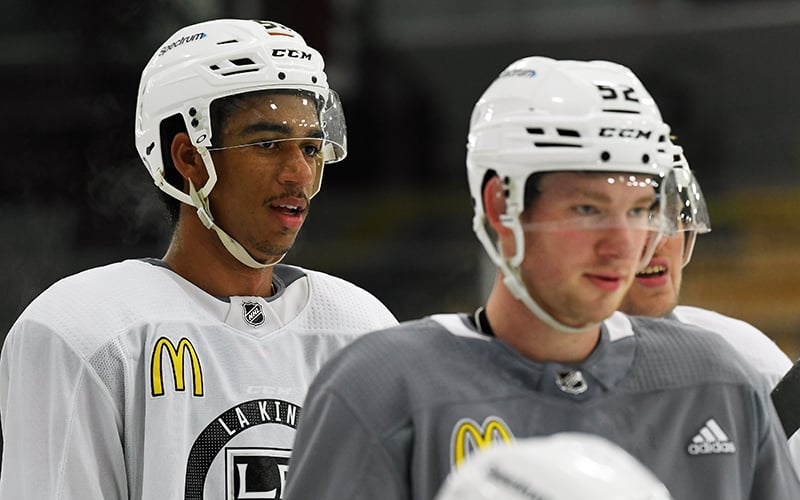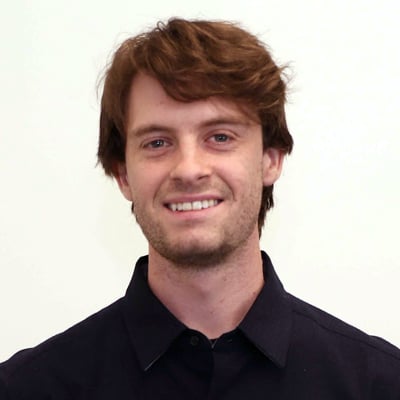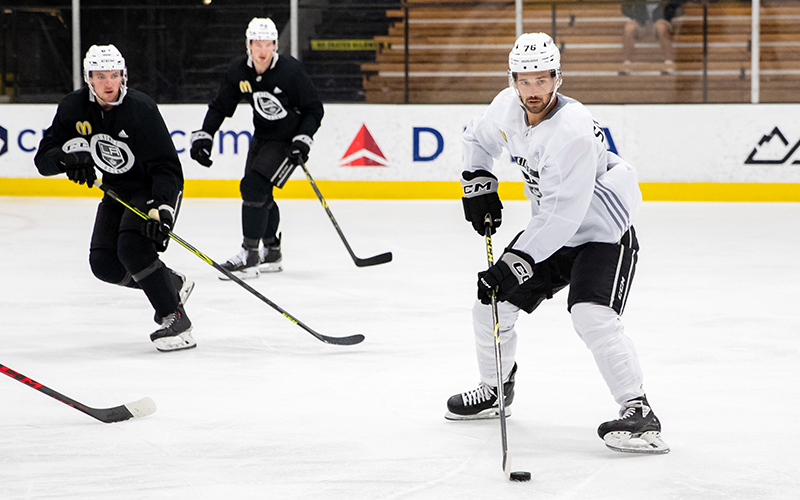
Quinton Byfield, left, of the Los Angels Kings said at the Kings development camp that the pandemic changed the trajectory of his career. (Photo by Juan Ocampo/NHLI via Getty Images)
LOS ANGELES – Los Angeles Kings defenseman Tobias Bjornfot smirked when he was referred to as “one of the older guys” by a reporter after a scrimmage at the Los Angeles Kings’ 2022 development camp. It makes sense why.
NHL development camps are for prospects, the newest members of the organization. The youngest of these players often arrive at camp mere days after being drafted. Youth abound, it can be strange to consider anyone other than the player development coaches a veteran of professional hockey.
Bjornfot was drafted in the first round in 2019, and has since played over 100 NHL games for the Kings. The reality is that players like Bjornfot, still years away from being considered a true NHL veteran, have seniority at training camp. Most importantly, they have been to a development camp before.
Here, they are the veterans. It can be funny to think about, but also a serious advantage for the organization and first-year camp invitees.
“I’m just trying to be a role model for (the younger prospects),” Bjornfot said.
The development camp veterans seem to have guaranteed roster spots for the upcoming Kings season. While younger prospects showcase their skills in hopes of earning an invite to the official Kings rookie camp in August, the older, more established prospects aim to share wisdom with the newest draft picks and prospects who look up to them.
“I want them to ask questions to me,” Bjornfot, a native of Upplands Vasby, Sweden, said. “Just to talk to them and be a nice guy.”
Needless to say, Bjornfot has accepted his place as a veteran role model among the team’s prospects. It’s exactly what the player development coaches leading the 2022 development camp are hoping to see.
Jordan Spence, a 2019 fourth round pick of the Kings and another of the development camp veterans, explicitly said the coach asked the older players to be role models for the newest prospects.
“Right when I landed Sunday we had a meeting,” Spence said. “(Kings coach) Todd (McLellan) brought myself, (Quinton) Byfield, (Arthur) Kaliyev, Bjornfot, all the guys, just to lead by example.”
Kings player development coach Mike Donnelly spoke about how important it is for the youngest players to have older prospects that have been through an NHL development camp before there to learn from. He praised players who aren’t afraid coming back to development camp for a second or third time in order to be that veteran presence and help the youngest prospects.
“I think in your organization if you’ve got guys like that, that are not afraid to come back to a development camp, thinking ‘oh all these new kids are coming in …” Donnelly said. “We’re able to fine-tune some of those skills we believe are important for playing in the NHL.”
Donnelly is one of five player development coaches who ran the drills and scrimmages at this summer’s development camp. As much as he would like to work with everyone evenly, it’s a challenge when there’s age and experience discrepancy.
“It makes a difference,” Donnelly said, comparing the evaluation of the more experienced players and the new players. “Obviously it’s a strength difference … I’ve got to see, fundamentally, is he OK? … What do I have to work on with this boy? What do I have to tell him to work on when he goes back? That’s what I’m looking at.”
Donnely also recognizes that older players returning to development camp can alleviate some of that challenge. The older players can act as extra coaching figures for the younger kids to learn from.
“It’s harder for the young kids when they come to their first development camp,” Donnelly said.
Donnelly specifically praised Samuel Fagemo, another Swedish Kings prospect drafted in 2019 as a winger, for coming into camp for a third time and wanting to continuously improve.
“Him coming here, it’s his third year, he got better every day,” Donnelly said. “He even admitted it to me today, he goes, ‘I’m so glad I came.’”
Obviously the older prospects keep learning hockey skills, too. There’s almost an expectation that they’ll perform the best in camp because they have that added experience. They have simply had more opportunities to play at this high of a level.
“Because of COVID and everything, I got to play a year in the AHL,” Quinton Byfield, the second overall pick in the 2020 draft said. “I learned a lot from those guys. … They kind of showed me the ropes. … So it was a little bit easier to adjust going into this year.”
Byfield was scheduled to continue playing on the Ontario Hockey League’s Sudbury Wolves for the 2020-21 season, but the pandemic forced the season to shut down. Because of that, he went to the American Hockey League’s Ontario Reign, the Kings’ affiliate team, earlier than expected.
“It was either OHL or junior if there wasn’t a pandemic,” Byfield said. “So who knows what would have happened?”
Every player drafted in 2020 or earlier has this extra time that attracts the attention of knowledge-hungry younger players.
The newest Kings defensemen watch Tobias Bjornfot and Jordan Spence control the puck on the blue line. The forwards hyper-focus on Fagemo’s hockey IQ, the skating of Byfield, and Arthur Kaliyev’s shot.
“We’re trying to do the best we can to just do the right things and show them what to do and what to expect,” Spence said.
Donnelly and the other player development coaches use the previous players’ experiences to really hone in on where they can improve. In a way, the older players become members of the development staff themselves.
“It’s kind of crazy that I’m one of the oldest guys here,” Spence said. “So we’re just trying to lead by example. It’s always good to just have a scrimmage and kind of get to know the guys.”
“There’s things that we believe in that we have to teach our players, or they’re never going to play,” Donnelly said. “Or they’re never going to have a chance to play. I think they’re all buying into it. This is all different teaching for these kids.”
When the younger players watch the coaches work with Byflield on stick position in the face-off circle or with Kaliyev on stick-handling, as opposed to the overall game elements they themselves work on, that can lead to more learning and emulation.
“It’s not just a one-day (thing), and then it’s out of your head,” Donnelly said. “You’ve got to bank this. You’ve got to put it in your memory bank.”
In the NHL, the veterans of development camp are still the new kids. They look toward the veterans on NHL rosters to guide them through their first years in the league. Now they’re doing the exact same thing for the newest prospects at development camp.
“It’s a lot of positive reinforcement,” Donnelly said. “That’s the culture we want. We’ve developed a really good culture here as far as teaching, developing, and winning. We want good kids that are going to work hard.”
Byfield has big role model for centers Phillip Danault and Kings captain Anze Kopitar. Fagemo and Kaliyev have the newly re-signed 30-goal scorer Adrian Kempe as a mentor on the wing.
The Kings defensive group is very young, but Bjornfot and Spence still have role models like franchise icon Drew Doughty, as well as 36 year-old swedish veteran Alex Edler, who was also re-signed by the Kings earlier this month.
“It’s good for us young D-Men that he’s back,” Bjornfot said of his countryman Edler.
Even though these older players like Edler and Kopitar don’t come to development camp, the young players who have played with them take that experience with them to it. It’s all about learning.
“There’s a lot of things that you learn this week,” Byfield said on the camp’s final day.
Added Donnelly: “I think it sets us apart from other organizations. As far as how we teach and what we demand as an organization.”

